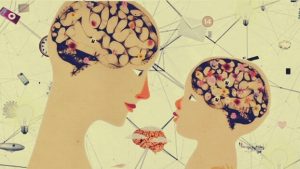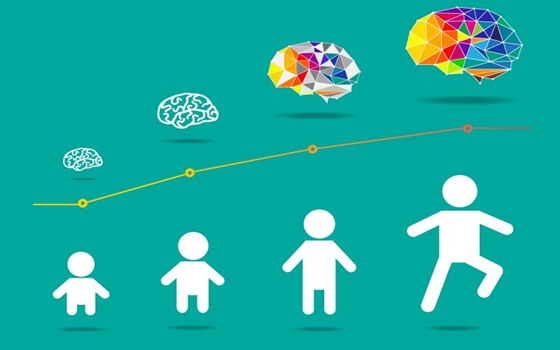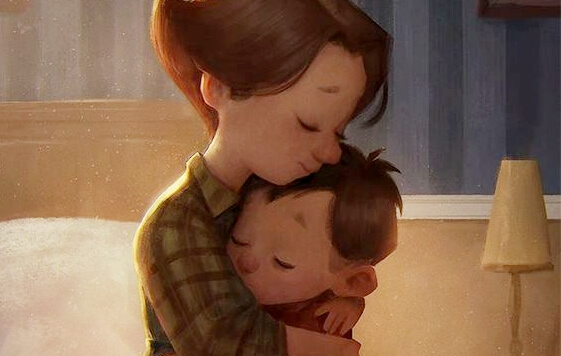5 Principles of Child Brain Development You Should Know


Written and verified by the psychologist Valeria Sabater
Knowing the processes and stages of child brain development is undoubtedly one of the best tools at our disposal to help our children grow and develop healthily.
We cannot forget that the psychological and emotional maturation of young children also depends on aspects that go far beyond nutrition and the daily care we provide with infinite love.
Let’s admit it: not all of us are gurus in childhood neuroscience and there is no day that goes by without some doubts in this area. We wonder, am I doing it right? Should I start some kind of early stimulation with my baby?
These questions are very normal, and for that reason, we want to suggest that you learn a little more about your child’s brain development through the 5 principles we will outline below.
We assure you that nothing is as fascinating as delving into that perfect and sophisticated organ that is the brain. In childhood, it has the greatest plasticity and potentiality.
The most important period in life is not university, but the first one of all: from birth to six years of age.
-Maria Montessori-
As parents, we have the ability to facilitate good brain development to make our little ones much happier.
1. 50% of intelligence is determined by genes
Many parents want to have smart children. This is often because we associate intelligence with personal success, without really knowing that there are other factors that are more fundamental to success, such as happiness.
- All this leads us to a series of reflections: our baby comes with a series of traits. One of those traits is intelligence, determined 50% by genes. Another is personality, such as introversion or extroversion.
- However, these genetic bases do not 100% determine what your little one will be like in the future. The way you raise him, the context in which he grows up and his learning opportunities will mark the other half.
Therefore, you must not forget a key aspect: emotional intelligence.
2. Child brain development goes from “the inside out”

What do we bean by child brain development going from “the inside out”?
- The basic architecture of the brain evolves through a continuous process that starts at birth and continues into adulthood.
- However, as Maria Montessori said, few life stages are as important as the brain development that occurs between the ages of 0 and 6 years old. But we want to point out something else: the key stage goes from 0 to 3 years.
- It is during this period that the brain experiences major changes, growth that goes from the inner part of the brain to the outermost part.
- The inner structures are related to the emotional world. Later with rapid growth, connections are refined and specialized to become more efficient.
- Thus, the last phases of child brain development are located in the cerebral cortex, where the most refined processes take place relating to decision-making, analysis, attention, and more.
This unstoppable and unique process encourages us to understand once again how important it is to take care of a child’s emotional world. Only then can we facilitate optimal and strong cerebral maturation.
3. Stress affects child brain development

Neurologists warn us about something that many moms and dads undoubtedly already know: continued stress throughout early childhood, whether due to poverty, abuse, lack of attachment or even due to mom’s depression, seriously affects the brain development of children.
In fact, it is known that children who have suffered some trauma have a much smaller hippocampus. This brain structure is linked to memory and the emotional world.
4. Year 3, the magical age
Did you know that the brain of a 3-year-old child is twice as active as that of an adult? This is a sensitive period, a moment that will never happen again and where our children have the maximum potential for learning.
However, how can we take advantage of this stage? Here are some basic keys to keep in mind:
- Development of the senses: your little one should interact with the environment through touch by walking in bare feet, exploring the world of colors and sounds, feeling different textures, etc.
- Development of language skills: read out loud, help your little one learn songs, etc.
- Development of motor skills: whenever you can, have your child practice fine motor skills related to the hands, especially hand-eye coordination. Also, try to always encourage free movement to practice walking and moving safely.
- Development of the emotional and social coefficient: age 3 is the age most suited for beginning to work on emotional intelligence and key aspects like empathy or recognizing emotions.
5. Love is key to child brain development

Love is the engine that moves the world and the seed that, in turn, makes our little ones grow by feeling protected, valued, cared for, etc.
For example, love and secure attachment facilitate the optimal development of the hippocampus, that aforementioned cerebral structure which is essential when it comes to learning, memorizing and managing stress.
In conclusion, we are more than confident that without being a renowned specialist in child neurology, you can apply these same recommendations right away with your children.
As mothers and fathers, oftentimes we almost instinctively know what is best for our children…
Knowing the processes and stages of child brain development is undoubtedly one of the best tools at our disposal to help our children grow and develop healthily.
We cannot forget that the psychological and emotional maturation of young children also depends on aspects that go far beyond nutrition and the daily care we provide with infinite love.
Let’s admit it: not all of us are gurus in childhood neuroscience and there is no day that goes by without some doubts in this area. We wonder, am I doing it right? Should I start some kind of early stimulation with my baby?
These questions are very normal, and for that reason, we want to suggest that you learn a little more about your child’s brain development through the 5 principles we will outline below.
We assure you that nothing is as fascinating as delving into that perfect and sophisticated organ that is the brain. In childhood, it has the greatest plasticity and potentiality.
The most important period in life is not university, but the first one of all: from birth to six years of age.
-Maria Montessori-
As parents, we have the ability to facilitate good brain development to make our little ones much happier.
1. 50% of intelligence is determined by genes
Many parents want to have smart children. This is often because we associate intelligence with personal success, without really knowing that there are other factors that are more fundamental to success, such as happiness.
- All this leads us to a series of reflections: our baby comes with a series of traits. One of those traits is intelligence, determined 50% by genes. Another is personality, such as introversion or extroversion.
- However, these genetic bases do not 100% determine what your little one will be like in the future. The way you raise him, the context in which he grows up and his learning opportunities will mark the other half.
Therefore, you must not forget a key aspect: emotional intelligence.
2. Child brain development goes from “the inside out”

What do we bean by child brain development going from “the inside out”?
- The basic architecture of the brain evolves through a continuous process that starts at birth and continues into adulthood.
- However, as Maria Montessori said, few life stages are as important as the brain development that occurs between the ages of 0 and 6 years old. But we want to point out something else: the key stage goes from 0 to 3 years.
- It is during this period that the brain experiences major changes, growth that goes from the inner part of the brain to the outermost part.
- The inner structures are related to the emotional world. Later with rapid growth, connections are refined and specialized to become more efficient.
- Thus, the last phases of child brain development are located in the cerebral cortex, where the most refined processes take place relating to decision-making, analysis, attention, and more.
This unstoppable and unique process encourages us to understand once again how important it is to take care of a child’s emotional world. Only then can we facilitate optimal and strong cerebral maturation.
3. Stress affects child brain development

Neurologists warn us about something that many moms and dads undoubtedly already know: continued stress throughout early childhood, whether due to poverty, abuse, lack of attachment or even due to mom’s depression, seriously affects the brain development of children.
In fact, it is known that children who have suffered some trauma have a much smaller hippocampus. This brain structure is linked to memory and the emotional world.
4. Year 3, the magical age
Did you know that the brain of a 3-year-old child is twice as active as that of an adult? This is a sensitive period, a moment that will never happen again and where our children have the maximum potential for learning.
However, how can we take advantage of this stage? Here are some basic keys to keep in mind:
- Development of the senses: your little one should interact with the environment through touch by walking in bare feet, exploring the world of colors and sounds, feeling different textures, etc.
- Development of language skills: read out loud, help your little one learn songs, etc.
- Development of motor skills: whenever you can, have your child practice fine motor skills related to the hands, especially hand-eye coordination. Also, try to always encourage free movement to practice walking and moving safely.
- Development of the emotional and social coefficient: age 3 is the age most suited for beginning to work on emotional intelligence and key aspects like empathy or recognizing emotions.
5. Love is key to child brain development

Love is the engine that moves the world and the seed that, in turn, makes our little ones grow by feeling protected, valued, cared for, etc.
For example, love and secure attachment facilitate the optimal development of the hippocampus, that aforementioned cerebral structure which is essential when it comes to learning, memorizing and managing stress.
In conclusion, we are more than confident that without being a renowned specialist in child neurology, you can apply these same recommendations right away with your children.
As mothers and fathers, oftentimes we almost instinctively know what is best for our children…
All cited sources were thoroughly reviewed by our team to ensure their quality, reliability, currency, and validity. The bibliography of this article was considered reliable and of academic or scientific accuracy.
- Blanco Paredes, H. (2017). Neuropsicología Infantil. Boletín Científico de La Escuela Superior de Atotonilco de Tula. https://repository.uaeh.edu.mx/revistas/index.php/atotonilco/article/view/2409
- Ostrosky, F. (2011). Desarrollo del sistema nervioso. Neurociencias.
- Rosselli, M., Matute, E., & Ardila, A. (2010). Neuropsicología del desarrollo infantil. Editorial El Manual Moderno.
- Rosselli, M. (2002). Maduración cerebral y desarrollo cognoscitivo. Revista Latinoamericana de Ciencias Sociales, Niñez y Juventud.
This text is provided for informational purposes only and does not replace consultation with a professional. If in doubt, consult your specialist.








